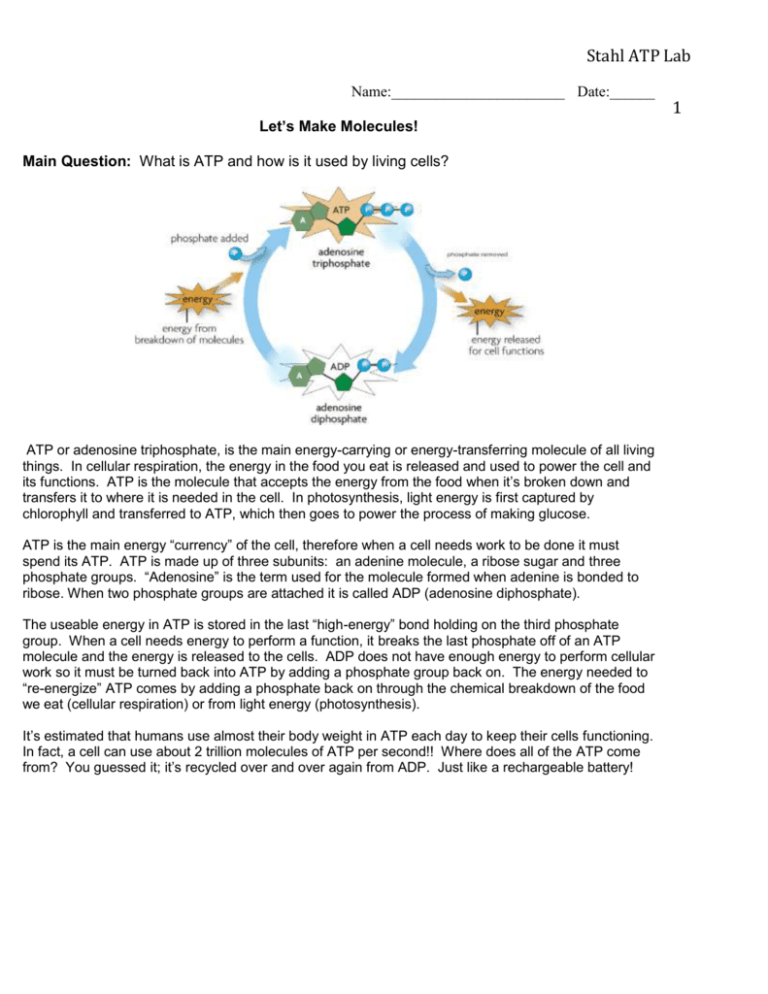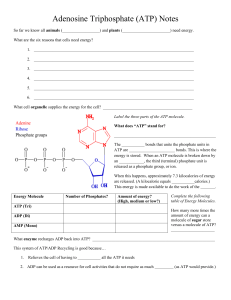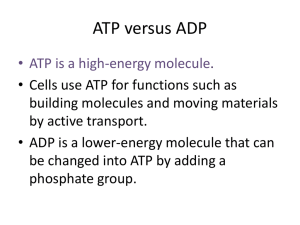Name
advertisement

Stahl ATP Lab Name:_______________________ Date:______ Let’s Make Molecules! Main Question: What is ATP and how is it used by living cells? ATP or adenosine triphosphate, is the main energy-carrying or energy-transferring molecule of all living things. In cellular respiration, the energy in the food you eat is released and used to power the cell and its functions. ATP is the molecule that accepts the energy from the food when it’s broken down and transfers it to where it is needed in the cell. In photosynthesis, light energy is first captured by chlorophyll and transferred to ATP, which then goes to power the process of making glucose. ATP is the main energy “currency” of the cell, therefore when a cell needs work to be done it must spend its ATP. ATP is made up of three subunits: an adenine molecule, a ribose sugar and three phosphate groups. “Adenosine” is the term used for the molecule formed when adenine is bonded to ribose. When two phosphate groups are attached it is called ADP (adenosine diphosphate). The useable energy in ATP is stored in the last “high-energy” bond holding on the third phosphate group. When a cell needs energy to perform a function, it breaks the last phosphate off of an ATP molecule and the energy is released to the cells. ADP does not have enough energy to perform cellular work so it must be turned back into ATP by adding a phosphate group back on. The energy needed to “re-energize” ATP comes by adding a phosphate back on through the chemical breakdown of the food we eat (cellular respiration) or from light energy (photosynthesis). It’s estimated that humans use almost their body weight in ATP each day to keep their cells functioning. In fact, a cell can use about 2 trillion molecules of ATP per second!! Where does all of the ATP come from? You guessed it; it’s recycled over and over again from ADP. Just like a rechargeable battery! 1 Stahl ATP Lab 2 Part A- The Chemical Structure of ATP ATP is a molecule that is produced & consumed in the cell. There are 3 subunits that comprise ATP: ribose, adenine and phosphoric acid (phosphate). Look at the following diagrams to answer these questions. 1. What is the molecular formula of ribose? C___ H___O___ 2. What is the molecular formula of adenine? C___H___N___ 3. What atom is present in adenine that was NOT present in ribose? _______ 4. What atom is present in ribose that is NOT present in Adenine? ________ 5. What is the molecular formula for phosphoric acid? H___P___O___ Part B: Constructing the ATP molecule Materials: 50 Toothpicks, assorted soft candies The following candies will represent the atoms: Hydrogen- 24 white marshmallows Oxygen- 18 different colored marshmallows Carbon- 10 Gummy Bears Phosphates- 3 Gumdrops Nitrogen- 5 Sour Patch Kids Step 1- Obtain all needed materials and keep them separated. Stahl ATP Lab Step 2- In groups of three, each person takes a molecule and recreates it using the specified candy. This should take about 10 minutes for each person to complete. Step 3- Raise your hand when you are complete so that the teacher can double check your models. Step 4- Now we are going to try to act out the ATP cycle. Step 5- Eat up and enjoy! Part C Converting ATP to ADP The equation is the following ATP ADP + Phosphate + Energy 1. What is the reactant in the equation? _____________________ 2. What are the products? ____________________ 3. What product has been released that will be used by the cell? _______________________ 4. What will the cell possible do with this newly released product? ____________________ Part D Converting ADP to ATP ATP can be formed within the mitochondria of a cell if the reactants are available. ADP + Phosphate group + Energy ATP 1. What are the reactants? ______________________________________ 2. What is the product? ____________ 3. Why does a cell want to convert ADP to ATP? 4. What is the advantage to having a vast supply of ATP in the cell? 5. What atom has to be added to turn the ADP back into an ATP molecule? Post Lab Questions 1. What carbon based molecules provide us with energy? 2. How many ATP do lipids yield? 3. How many ATP do carbohydrates yield? 4. What does ATP stand for? 5. What is ATP used for in cells? 3 Stahl ATP Lab 4 6. Label the diagram 7. In your own words explain the relationship between ATP and ADP.






